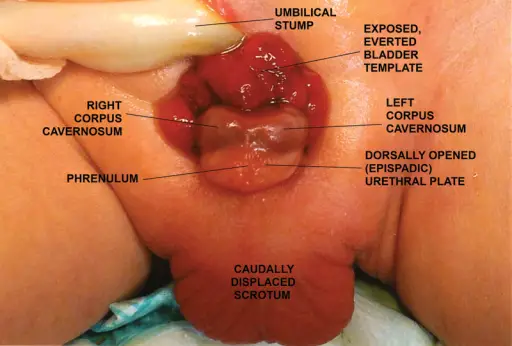Exstrophy of the bladder is a congenital anomaly that exists along the spectrum of the exstrophy-epispadias complex, and most notably involves protrusion of the urinary bladder through a defect in the abdominal wall.
What is the Pathology of Exstrophy of the Bladder?
The pathology of exstrophy of the bladder is:
-Etiology: The cause is not yet clinically established but is thought to be in part due to failed reinforcement of the cloacal membrane by underlying mesoderm.
-Genes involved: ISL1.
-Pathogenesis: The sequence of events that lead to exstrophy of the bladder is a developmental abnormality that occurs 4-5 weeks after conception in which the cloacal membrane is not replaced by tissue that will form the abdominal muscles.
-Histology: The histology associated with exstrophy of the bladder shows acute and chronic inflammation; lamina propria fibrosis.
How does Exstrophy of the Bladder Present?
Patients with exstrophy of the bladder typically affect males two or six times more than females presenting at birth. The symptoms, features, and clinical findings associated with exstrophy of the bladder include a flattened puborectal sling, separation of the pubic symphysis. shortening of a pubic ramus, external rotation of the pelvis.
How is Exstrophy of the Bladder Diagnosed?
The diagnosis of exstrophy bladder is clinical and does not require any other additional investigations. Routine hemogram and blood chemistry are performed as a part of the preoperative work-up.
How is Exstrophy of the Bladder Treated?
Exstrophy of the bladder is treated by surgical excision.
What is the Prognosis of Exstrophy of the Bladder?
The prognosis of exstrophy of the bladder is good with the most important criterion for improving long-term prognosis being the success of the initial closure.



